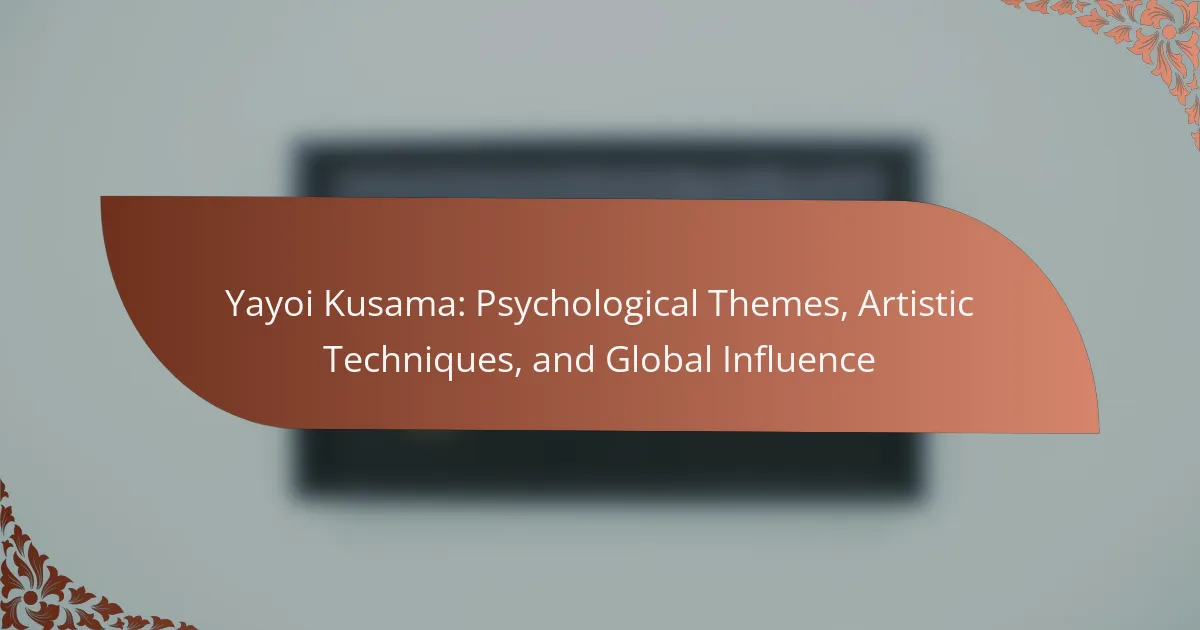Yayoi Kusama’s art explores psychological themes, particularly mental health and obsession. Her distinctive techniques include polka dots and immersive installations. This article examines her global influence, the integration of personal experiences in her work, and how her artistic expression fosters emotional connections with audiences.
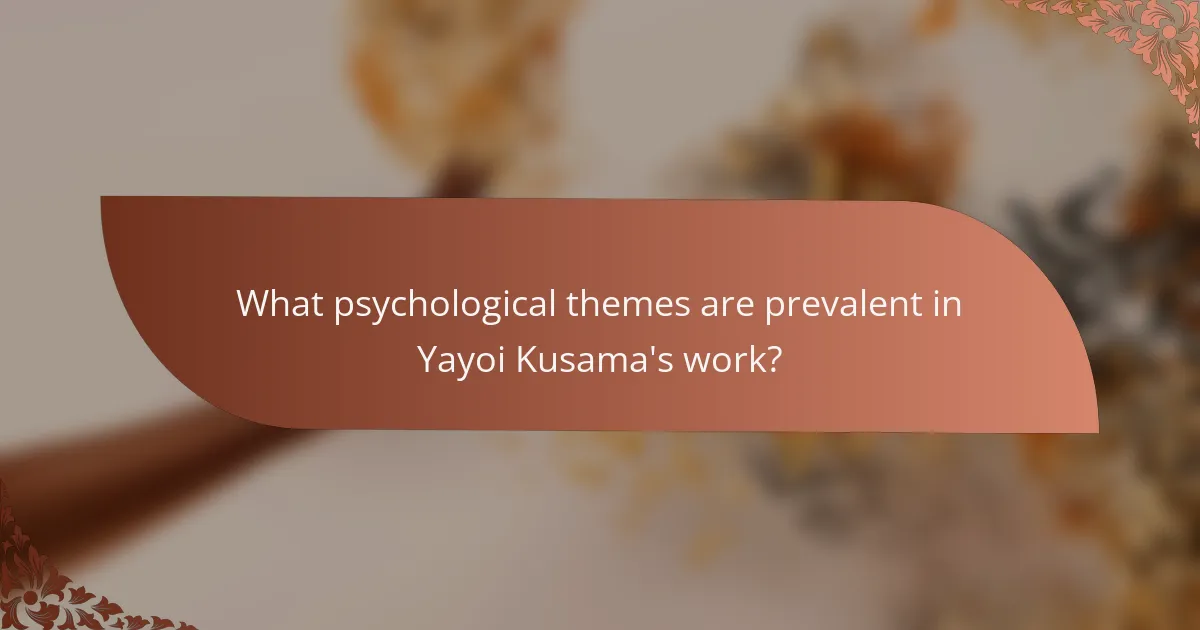
What psychological themes are prevalent in Yayoi Kusama’s work?
Yayoi Kusama’s work prominently features themes of obsession, infinity, and mental health. Her use of repetitive patterns and polka dots symbolizes her struggle with psychological issues. These motifs create immersive environments that reflect her experiences with anxiety and hallucinations. Kusama’s art serves as both a personal catharsis and a universal commentary on the human condition.
How does Kusama’s personal history influence her artistic expression?
Yayoi Kusama’s personal history profoundly shapes her artistic expression through themes of obsession and mental health. Her experiences with hallucinations and anxiety inform her repetitive motifs, such as polka dots and infinity nets. These motifs symbolize her struggle with identity and the cosmos. Additionally, her early life in Japan during World War II instilled a sense of trauma that resonates in her work, allowing audiences to connect with her psychological depth. Kusama’s unique narrative transforms her art into a reflection of her internal battles, making her a pivotal figure in contemporary art.
Which mental health issues are explored through her art?
Yayoi Kusama explores various mental health issues through her art, including anxiety, obsession, and trauma. Her work reflects her experiences with mental illness, particularly her struggles with obsessive-compulsive disorder and depression. The repetitive patterns and immersive installations symbolize her internal battles and the desire for escape. Additionally, her use of polka dots and infinity rooms represents a quest for connection and transcendence, illustrating the complex relationship between her psyche and creativity.
What role does repetition play in conveying psychological concepts?
Repetition is crucial in conveying psychological concepts as it reinforces themes and fosters deeper understanding. Yayoi Kusama employs repetition in her art to explore themes of infinity and self-obliteration, emphasizing the psychological impact of her experiences. This technique allows viewers to engage with her work on a profound level, promoting reflection on their own perceptions and emotions. The repetitive patterns in her pieces symbolize the cyclical nature of mental states, enhancing the emotional resonance of her art.
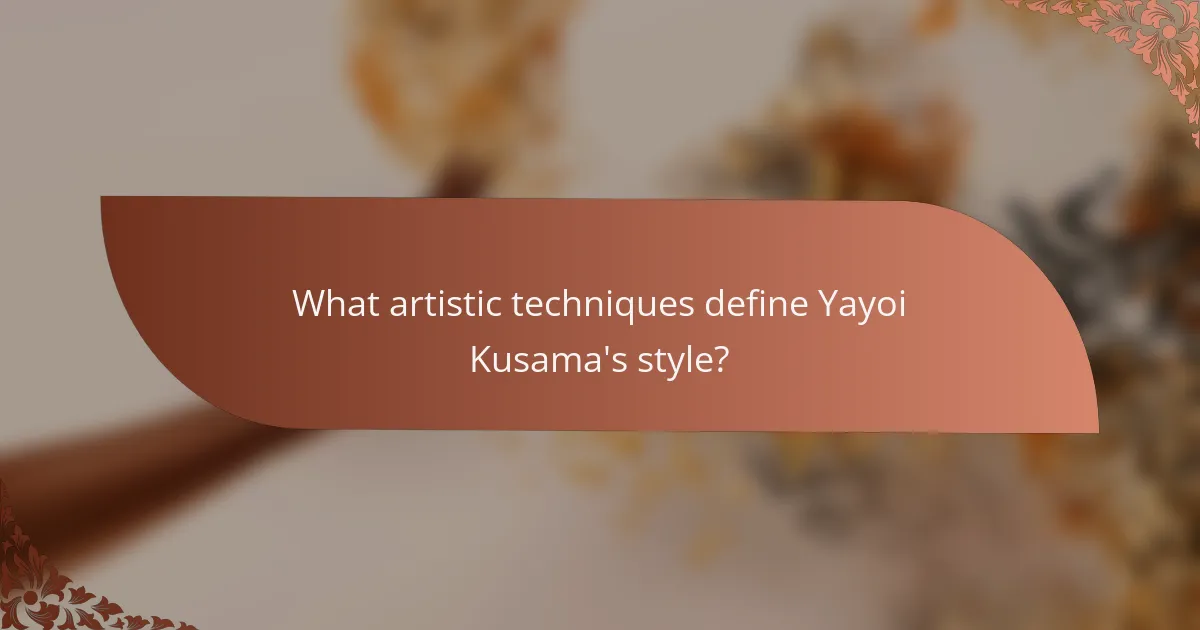
What artistic techniques define Yayoi Kusama’s style?
Yayoi Kusama’s style is defined by polka dots, infinity nets, and immersive installations. Her techniques include repetitive patterns, vibrant colors, and a focus on psychological themes. Kusama often uses large-scale installations to create environments that challenge perceptions of space and self. Her unique attribute is the integration of her personal experiences with mental health, which deeply influences her artistic expression.
How does the use of color impact the viewer’s perception?
Color significantly influences viewer perception by evoking emotions and shaping interpretations. Yayoi Kusama employs vibrant hues to create immersive experiences, often reflecting themes of obsession and infinity. For example, her use of bold red can evoke passion, while soft pastels may induce calmness. This strategic application of color enhances the psychological impact of her work, drawing viewers into her unique artistic world. The emotional responses elicited by color choices are crucial in understanding the depth of Kusama’s artistic techniques and their global influence.
What materials and mediums are frequently utilized by Kusama?
Yayoi Kusama frequently utilizes a variety of materials and mediums, including painting, sculpture, installation, and performance art. Her signature polka dots and infinity nets are prominent in her work. Kusama often incorporates unconventional materials like fabric, mirrors, and organic objects, enhancing her themes of repetition and infinity. Additionally, she uses digital media and immersive environments to engage viewers in her psychological explorations.
How does her installation art engage with space and audience?
Yayoi Kusama’s installation art profoundly engages with space and audience through immersive experiences. Her use of polka dots and reflective surfaces creates an enveloping environment, encouraging viewers to interact and reflect. This engagement transforms the perception of space, making it both personal and collective. The psychological themes in her work invite introspection, fostering a deeper connection with the audience.
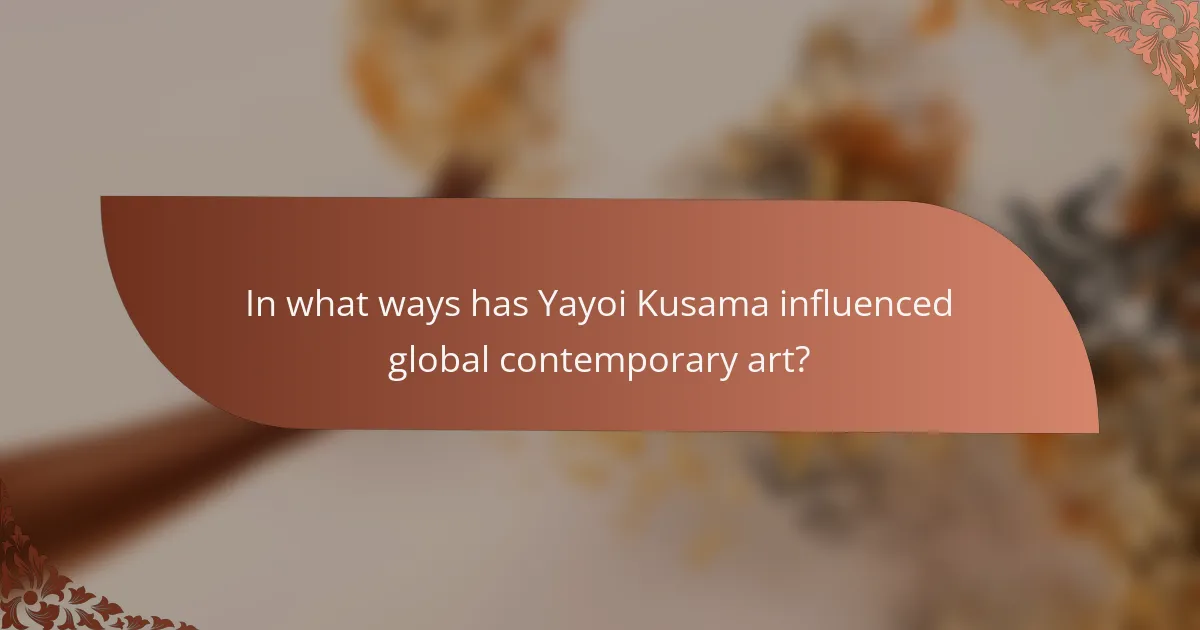
In what ways has Yayoi Kusama influenced global contemporary art?
Yayoi Kusama has significantly influenced global contemporary art through her exploration of psychological themes, unique artistic techniques, and impactful global presence. Her signature polka dots and immersive installations challenge perceptions of reality and identity. Kusama’s works address mental health, reflecting her personal experiences, which resonates with audiences worldwide. Additionally, her innovative use of space and repetition has inspired countless artists, promoting a dialogue on the intersection of art and personal narrative. As a result, Kusama’s influence extends beyond visual aesthetics, shaping contemporary discussions on mental health and self-expression in art.
Which artists cite Kusama as an inspiration?
Many contemporary artists cite Yayoi Kusama as an inspiration, including Takashi Murakami, Damien Hirst, and Olafur Eliasson. These artists draw from her unique use of color, pattern, and psychological themes. Kusama’s influence extends to various art forms, inspiring movements like pop art and contemporary installation art. Her exploration of infinity and self-obliteration resonates with many, shaping their creative expressions.
How have her exhibitions shaped public understanding of art?
Yayoi Kusama’s exhibitions have profoundly influenced public understanding of art by merging personal experiences with universal themes. Her immersive installations invite viewers to confront psychological concepts like obsession and infinity. This engagement fosters a deeper appreciation for emotional narratives in art. Additionally, her unique use of polka dots and vibrant colors challenges traditional boundaries, making contemporary art accessible to diverse audiences. As a result, Kusama has reshaped perceptions of creativity, encouraging dialogue about mental health and the human experience.
What cultural movements align with Kusama’s artistic philosophy?
Yayoi Kusama’s artistic philosophy aligns with movements such as Surrealism, Minimalism, and Feminism. Surrealism influences her exploration of the unconscious mind and dreams. Minimalism reflects in her repetitive patterns and forms. Feminism is evident in her challenge to gender norms and societal expectations. These movements enhance her unique perspective on mental health and identity.
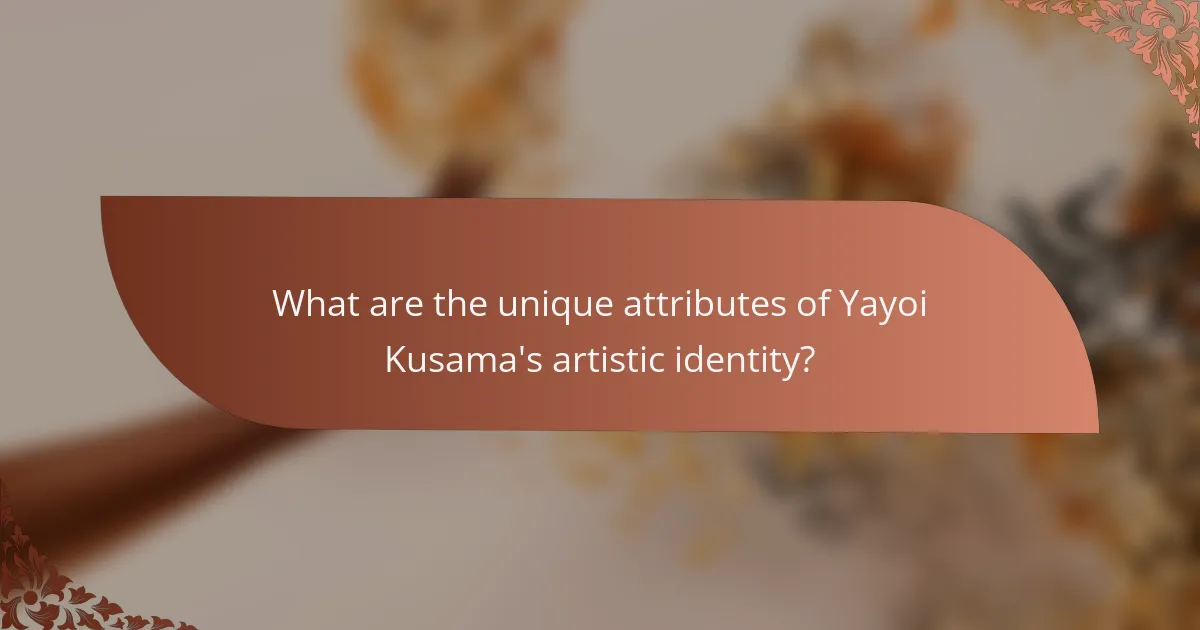
What are the unique attributes of Yayoi Kusama’s artistic identity?
Yayoi Kusama’s unique attributes include her use of polka dots, immersive installations, and exploration of infinity. Her psychological themes address mental health and obsession. The integration of personal experiences fosters a distinct artistic identity. Additionally, her global influence is evident through collaborations and exhibitions worldwide.
How does her use of polka dots symbolize her personal narrative?
Yayoi Kusama’s use of polka dots symbolizes her personal narrative by representing her struggles with mental health and a quest for identity. The repetitive patterns reflect her obsessive thoughts and desire for infinity, encapsulating her experiences of isolation and connection. Polka dots serve as a visual language through which she communicates her inner world, transforming personal trauma into universal themes of existence. This unique attribute of her work allows viewers to engage with her psychological themes and artistic techniques on a deeper level.
What distinguishes her from other contemporary artists?
Yayoi Kusama stands out among contemporary artists due to her unique psychological themes, immersive artistic techniques, and significant global influence. Her use of polka dots and infinity rooms creates an unparalleled sensory experience. Kusama’s exploration of mental health and obsession resonates deeply, making her work both personal and universally relatable. Additionally, her impact on the art world is evident through numerous exhibitions and collaborations, solidifying her status as a pioneering figure.
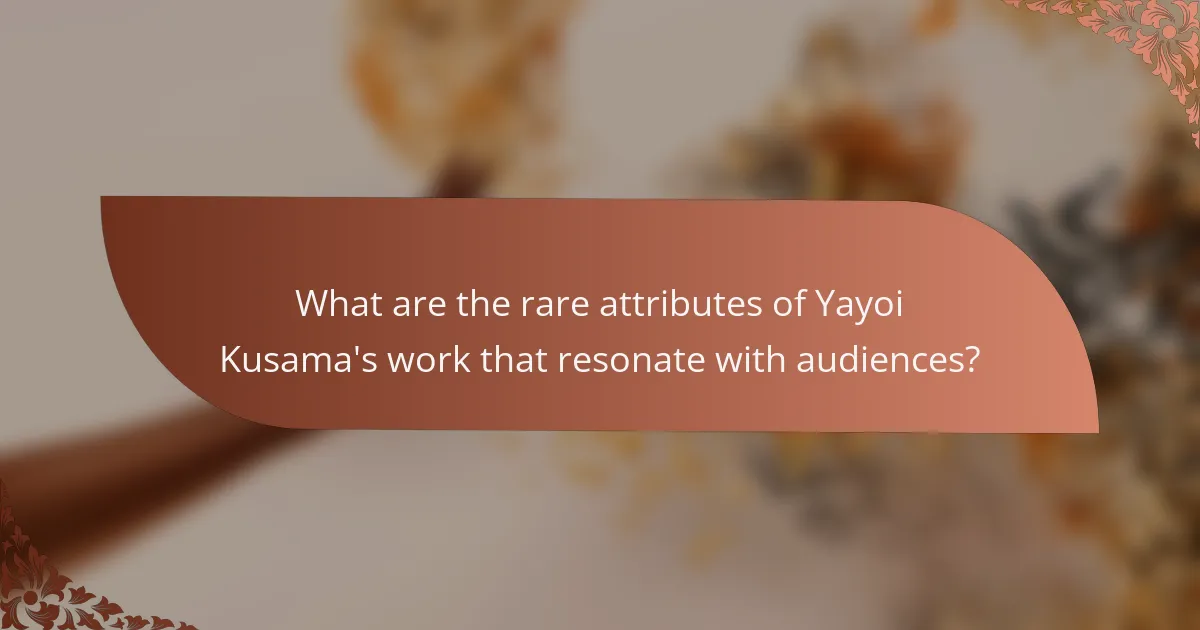
What are the rare attributes of Yayoi Kusama’s work that resonate with audiences?
Yayoi Kusama’s work resonates with audiences due to its unique attributes, such as her immersive environments, use of polka dots, and exploration of infinity. These elements create a distinct emotional connection and provoke introspection. Her ability to merge personal experiences with universal themes enhances the impact of her art. Additionally, Kusama’s pioneering role in feminist art and mental health advocacy further distinguishes her work, making it relevant and relatable to diverse audiences.
How does her engagement with infinity challenge traditional art boundaries?
Yayoi Kusama’s engagement with infinity redefines traditional art boundaries by immersing viewers in her unique vision. Her use of polka dots and infinity rooms creates an experience that transcends physical space, challenging perceptions of reality. This immersive approach evokes psychological themes of obsession and self-identity, inviting deep introspection. By merging art with personal narrative, Kusama expands the definition of art, making it a transformative experience rather than a mere visual representation.
What unique collaborations has she undertaken in her career?
Yayoi Kusama has collaborated with various artists and brands, enhancing her global influence. Notably, she partnered with Louis Vuitton, creating a unique collection that featured her signature polka dots. Additionally, her work has been integrated into large-scale installations, such as the Infinity Mirror Rooms, which have been exhibited worldwide. These collaborations reflect her unique ability to blend psychological themes with commercial art, expanding her reach across different mediums.
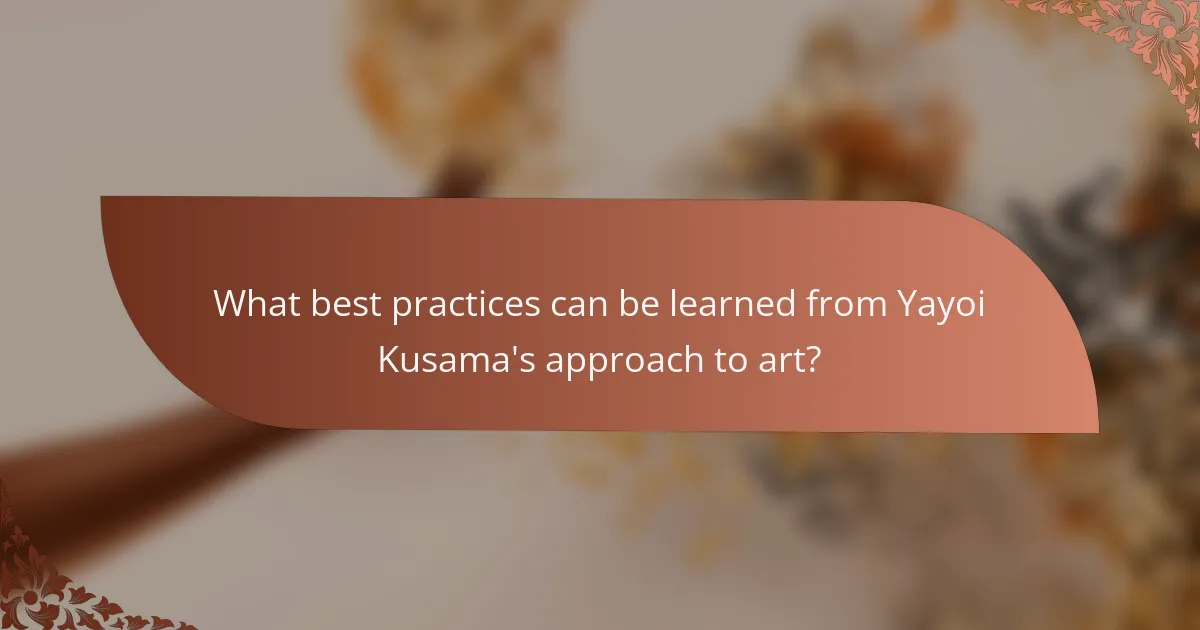
What best practices can be learned from Yayoi Kusama’s approach to art?
Yayoi Kusama’s approach to art emphasizes self-expression, repetition, and immersive experiences. Her use of polka dots symbolizes infinity and psychological themes, fostering a deep connection with viewers. Techniques like installation art create environments that invite participation, enhancing emotional engagement. Her global influence encourages artists to explore personal narratives and challenge societal norms.
How can contemporary artists incorporate psychological themes in their work?
Contemporary artists can incorporate psychological themes by exploring personal experiences and mental health narratives. Yayoi Kusama exemplifies this approach through her immersive installations and polka dot motifs, reflecting her struggles with obsessive-compulsive disorder. Her work invites viewers to engage with themes of infinity and self-identity, fostering a dialogue about mental health. Additionally, employing techniques such as repetition and vibrant colors enhances emotional resonance, allowing audiences to connect deeply with psychological concepts. This fusion of art and psychology not only broadens artistic expression but also raises awareness about mental health issues globally.
What strategies can be used to create immersive art experiences?
To create immersive art experiences, artists can employ interactive installations, sensory engagement, and thematic storytelling. Yayoi Kusama utilizes repetition and infinity in her works to evoke psychological themes, enhancing viewer participation and emotional connection. By incorporating technology, such as augmented reality, artists can further deepen audience immersion. Collaborative projects can also amplify global influence, encouraging community involvement and diverse perspectives.
